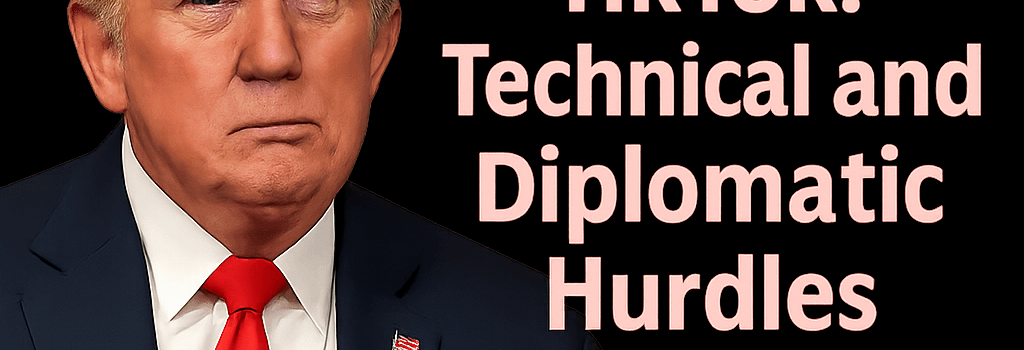Trump’s US-Only TikTok: Technical and Diplomatic Hurdles

Overview
With the September 17 deadline looming under the Protecting Americans from Foreign Adversary Controlled Applications Act, the Trump administration is racing to carve TikTok out of Chinese control. Though former President Trump recently told reporters “we pretty much have a deal,” a tangle of technical, legal and diplomatic obstacles suggests the resulting US-only TikTok may be plagued by bugs, reduced performance and uncertain security assurances.
1. Diplomatic & Regulatory Landscape
Beijing has repeatedly insisted that any sale of ByteDance’s crown-jewel algorithm constitutes an export of Chinese technology and thus requires state approval. A recent statement by Foreign Ministry spokesperson Mao Ning reiterated that China demands an “open, fair, just and non-discriminatory” review process, casting doubt on Trump’s plan to circumvent approval via a lease or licensing arrangement.
“Even if Beijing overlooks recent tariff hikes and chip curbs, algorithms underpinning TikTok’s recommendation engine remain a strategic national asset,” says Alex Capri, lecturer at the National University of Singapore’s Business School.
2. Technical Architecture of the Proposed US TikTok
Reports from The Information indicate a separate US-only app codenamed Project Whisper will spin up by September 5. This involves:
- Algorithm Separation: Forking the core recommendation engine in a US-based cloud environment (likely AWS GovCloud or Azure Government).
- Data Migration: Securely transferring up to 170 million US user profiles and video metadata via encrypted pipelines—estimated at 1–2 PB of data.
- Containerization: Deploying microservices in Kubernetes clusters with strict zero-trust networking controls.
However, cloud architects warn that live stateful session data and personalized models cannot be “leased” offsite without significant latency spikes or recommendation drift:
“A TTL mismatch in the feature store or GPU provisioning imbalance could degrade feed relevance by up to 30%. Users will notice,” explains Dr. Fiona Chen, a former AWS data engineer.
3. Security, Auditing & Compliance
The US spin-off must meet stringent CFIUS and NIST guidelines. Proposed safeguards include:
- Third-party code audits of the recommendation algorithm.
- Real-time intrusion detection via AI-powered threat analytics (e.g., CrowdStrike, Palo Alto Cortex XDR).
- Periodic FedRAMP High recertification of the cloud infrastructure.
Yet experts note that without China’s cooperation to sanitize the codebase, backdoors or hard-coded data calls to ByteDance servers may persist.
4. Impact on Creators and Business Models
For the 5 million US TikTok creators who earn income through live commerce and short-video ads, any algorithmic hiccup could slash engagement rates by double digits. ByteDance’s fast-growing TikTok Shop pivot relies on seamless recommendation loops; a faulty rollout could shift sellers to rivals like Instagram Reels or Snap Spotlight.
5. Additional Analysis Sections
5.1 Comparative Case Study: WeChat in the US
Similar efforts to bifurcate WeChat faced intense code-audit scrutiny and resulted in a down-tiered app with limited features. Lessons learned:
- Feature parity is critical to retain user base.
- Regional app stores may need distinct binaries, doubling maintenance overhead.
5.2 Alternative Scenarios: Partial Divestiture vs. Full Fork
Two models under discussion:
- Partial Divestiture: ByteDance retains <20% equity, US consortium (Oracle, Blackstone, a16z) holds operational control.
- Full Fork: US entity licenses cleaned algorithm but builds all ML pipelines from scratch—estimated cost: $200 million+ and 12–18 months of R&D.
5.3 Long-Term Outlook: Global Tech Decoupling
As US-China tech bifurcation accelerates, multinational apps face:
- Fragmented user experiences by region.
- Increased compliance complexity with diverging data-sovereignty laws.
- Escalating costs for parallel R&D efforts in AI and cloud infrastructure.
6. Next Steps & Timeline
If Beijing signs off—which remains unlikely—the consortium plans a phased switchover:
- September 5, 2025: Launch US-only app in App Store and Google Play.
- Q4 2025: Migrate 25% of daily active users (DAU) per month.
- March 2026: Sunset original TikTok app for US IP addresses.
Conclusion
Although Trump asserts the deal is “good for China and the US,” multiple stakeholders—from Chinese regulators to US cloud architects—remain skeptical. Even if an agreement is signed, the technical complexity of algorithm forks, the burden of data migration and the imperative of airtight security audits suggest users could face a glitchy, less personalized TikTok experience this fall.